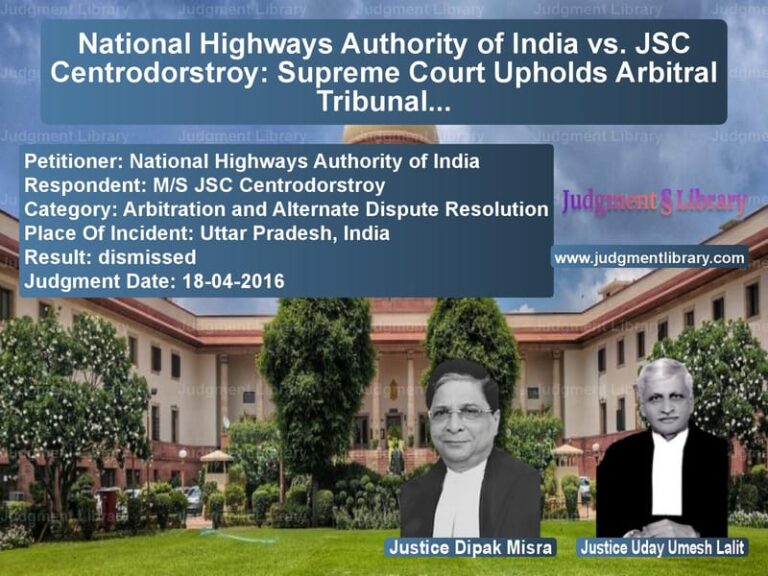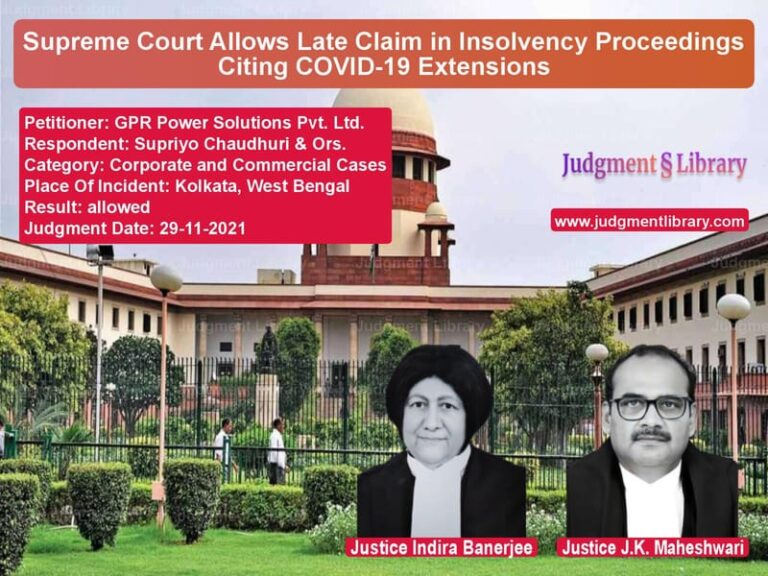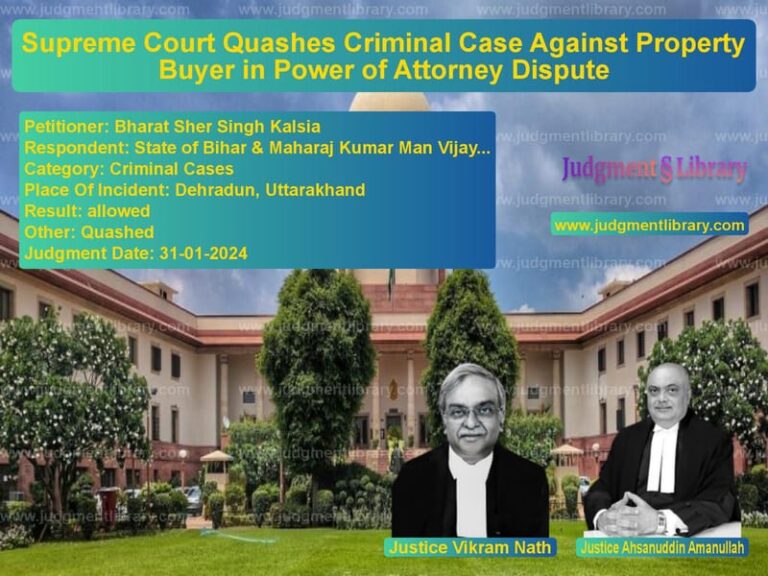State of Uttarakhand vs. Darshan Singh: Supreme Court Upholds Acquittal in Murder Case
The case of State of Uttarakhand vs. Darshan Singh & Others involves an appeal against the acquittal of the accused in a murder case. The Supreme Court was tasked with determining whether the High Court had rightly overturned the conviction issued by the Trial Court under Sections 147, 148, 149, and 302 of the Indian Penal Code (IPC).
The case highlights the principles governing criminal appeals, the importance of consistency between medical and ocular evidence, and the limitations of judicial review in acquittal cases.
Background of the Case
The prosecution’s case was based on the complaint lodged by Swarn Singh (PW1), who alleged that on August 22, 1992, his father was murdered in a planned attack. The complaint stated:
- Swarn Singh, his father (the deceased), his mother, and his maternal uncle were traveling on a tractor from Nanakmatta to their village.
- About one kilometer from their house, they encountered a bullock cart blocking the road.
- As the tractor stopped, the accused—led by Pahalwan Singh—emerged from hiding.
- Resham Singh fired a shot from a country-made pistol, hitting the deceased in the back.
- Other accused—Darshan Singh, Daleep Singh, Jagir Singh, and Veer Singh—attacked the deceased with swords, spears, and other weapons.
- The accused fled the scene in the bullock cart after committing the crime.
An FIR was registered under Sections 147, 148, 149, and 302 of the IPC. The accused were charged and the trial commenced.
Trial Court’s Judgment
The Trial Court convicted Pahalwan Singh, Resham Singh, Daleep Singh, Veer Singh, and Darshan Singh under Sections 302, 148, and 149 of the IPC. However, Resham Singh and Darshan Singh were acquitted of the charges under the Arms Act due to lack of evidence.
High Court’s Acquittal
The High Court overturned the conviction, citing the following reasons:
- There were material inconsistencies in the statements of key prosecution witnesses, PW1 (Swarn Singh) and PW2.
- PW2 was not an independent witness, being distantly related to the informant.
- PW4 (the maternal uncle) turned hostile and did not support the prosecution’s case.
- The claim that the accused fled the scene in a bullock cart was deemed implausible.
- PW1 and PW2 provided contradictory statements about whether the tractor’s headlights were on at the time of the attack.
- Medical evidence contradicted the prosecution’s claim that the accused fired from the front, as the deceased suffered a gunshot wound in the back.
- The post-mortem report did not align with the eyewitness accounts.
As a result, the High Court acquitted all accused, leading to an appeal by the State of Uttarakhand before the Supreme Court.
Arguments Before the Supreme Court
Arguments by the State of Uttarakhand
- The High Court erred in finding inconsistencies between the medical and eyewitness evidence.
- The prosecution’s case was supported by an FSL report, which confirmed that the bullet was fired from a weapon recovered from one of the accused.
- The FIR was lodged promptly, within three hours of the incident.
- Minor discrepancies should not have led to an acquittal, as the overall case was strong.
Arguments by the Defense (Darshan Singh & Others)
- There was no direct evidence linking the accused to the crime.
- The prosecution failed to establish motive.
- The medical evidence contradicted the eyewitness statements, making the prosecution’s case unreliable.
- The accused had already been acquitted under the Arms Act, further weakening the prosecution’s argument.
Supreme Court’s Judgment
The Supreme Court upheld the High Court’s acquittal, citing the following key findings:
1. Discrepancies Between Ocular and Medical Evidence
- The prosecution witnesses claimed that the accused fired from the front, yet medical reports confirmed that the fatal gunshot wound was in the back.
- This contradiction raised doubts about the credibility of the eyewitness testimony.
2. Contradictory Testimony from Key Witnesses
- PW1 claimed that the tractor headlights were on, while PW2 claimed they were off.
- PW4, who was in the tractor, turned hostile and denied seeing the attack.
- The High Court correctly found that these inconsistencies created reasonable doubt.
3. No Evidence Supporting the Claim That the Accused Fled in a Bullock Cart
- The prosecution’s claim that the accused fled in a bullock cart after committing murder was deemed highly improbable.
- The High Court was right to question the plausibility of this sequence of events.
4. The High Court’s Acquittal Was Based on Strong Grounds
- The Supreme Court emphasized that acquittals should not be overturned lightly.
- Intervention is only warranted if the lower court’s decision is perverse or based on an erroneous application of law.
- Since the High Court had valid reasons for acquitting the accused, there was no justification for interference.
Impact of the Judgment
This judgment has significant implications:
- Reinforces the Importance of Consistency in Evidence: Medical evidence must align with eyewitness testimony for a conviction.
- Strengthens the Presumption of Innocence: Acquittals should not be overturned unless there is compelling evidence.
- Limits Judicial Interference in Criminal Appeals: The Supreme Court reaffirmed that it will not reassess factual findings unless the lower court’s judgment is perverse.
Conclusion
The Supreme Court’s ruling in this case highlights the importance of credible and consistent evidence in criminal trials. By upholding the High Court’s acquittal, the judgment reinforces the fundamental principle that an accused must be proven guilty beyond reasonable doubt. The case serves as a reminder that minor inconsistencies can undermine a prosecution’s case, especially when medical evidence contradicts eyewitness accounts.
Petitioner Name: State of Uttarakhand.Respondent Name: Darshan Singh & Others.Judgment By: Justice Sanjay Kishan Kaul, Justice K.M. Joseph.Place Of Incident: Uttarakhand.Judgment Date: 07-11-2019.
Don’t miss out on the full details! Download the complete judgment in PDF format below and gain valuable insights instantly!
Download Judgment: State of Uttarakhand vs Darshan Singh & Othe Supreme Court of India Judgment Dated 07-11-2019.pdf
Direct Downlaod Judgment: Direct downlaod this Judgment
See all petitions in Murder Cases
See all petitions in Bail and Anticipatory Bail
See all petitions in Legal Malpractice
See all petitions in Judgment by Sanjay Kishan Kaul
See all petitions in Judgment by K.M. Joseph
See all petitions in dismissed
See all petitions in supreme court of India judgments November 2019
See all petitions in 2019 judgments
See all posts in Criminal Cases Category
See all allowed petitions in Criminal Cases Category
See all Dismissed petitions in Criminal Cases Category
See all partially allowed petitions in Criminal Cases Category







